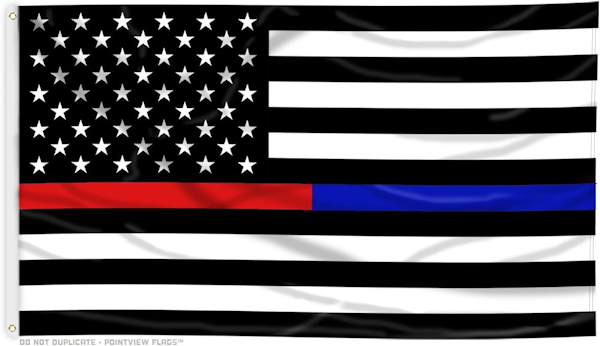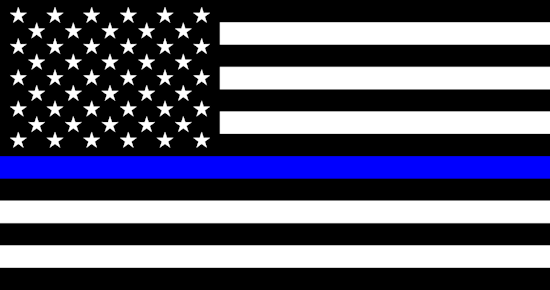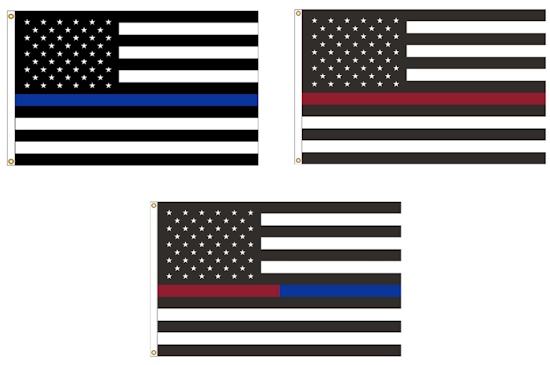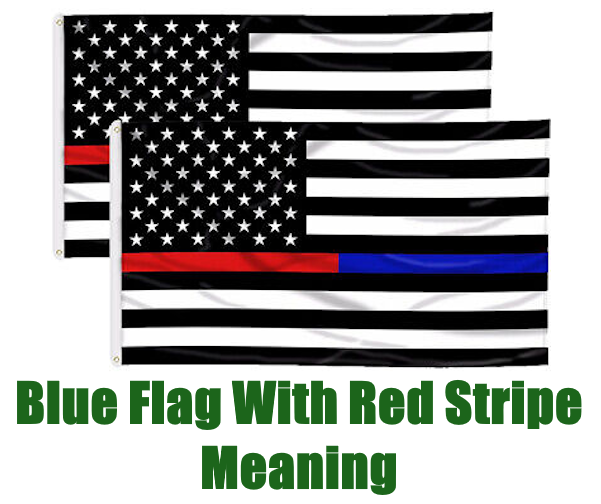Have you ever noticed the blue flag with a red stripe and wondered what was the purpose of it?
There are numerous U.S. flag variations, each with its own specific meaning and representation.
Often, the colors of the flag reveal the symbolism and other hidden meanings of it.
Learn more about the purpose and history of the blue flag with a red stripe, below.
Related Article – 16 Symbols For Freedom & Liberty In America
Table of Contents
Blue Flag with Red Stripe Meaning

What is the purpose of the American blue flag with a red stripe?
The flag variation started showing up outside porches and buildings, but what exactly does it mean?
In general, the red stripe acknowledges the work and sacrifice of firefighters, while the blue strip represents the duty of police officers.
Often, these are the only colors present on the American flag, as the rest of it is black and white.
These types of flags are purposely left black and white in order to put emphasis on a certain color.
As a result, it’s a combination of the Thin Blue Line Flags and Thin Red Line Flags many people have witnessed in the past (see, history).
The red and blue stripe usually runs down the middle of the black while the rest of the stripes alternate black and white.
The U.S. flag is unique in that it acknowledges the courage and dedication of multiple types of first responders, including police and firefighters.
Today, many first responders hang the U.S. flag variation in their homes, vehicles, or places of work.
History of the American Flag (Thin Blue & Red Stripe)

The history of the U.S. flag featuring a thin blue and red stripe is not completely known.
However, there are a few theories as to its origin, including some historians projecting the flag variant goes back to the mid-1800s.
The theory claims that British forces, decorated in their infamous red coats, organized into 2-row firing lines while engaged in combat during the Crimean War.
The vantage from afar of the troop formation resembled a “thin red line.”
Consequently, the reference transformed into a figure of speech over time.
Whereas in the past a “thin red line” represented a tightly configured, or thinly spread military unit, today, it often means something much different.
Recently, many American flag variations have become popular including the Thin Blue Line and Thin Red Line Flags.
U.S. Flags for First Responders
First responders like police officers, firefighters, and medical personnel have come to embrace different versions of the American flag.
These include the black and white, thin blue and red stripe flags common with first responders.
Additionally, it incorporates the blue flag with a red stripe version, which combines the 2 groups into one symbolic flag.
First responders have embraced these flags because they show support for law enforcement and other important safety personnel.
The term “blue line” was coined metaphorically to acknowledge how law enforcement keeps society safe and free from spiraling into chaos.
Meanwhile, the “red line” represents much the same meaning, given the rare ability of firefighters to save lives and burning infrastructure.
The Purpose of Blue Flag with Red Stripe
What is the main purpose of the blue flag with a red stripe that is otherwise black and white?
The type of American flag was created to show support and solidarity for police and fire service personnel.
Moreover, the thin red and blue lines are designed to remember injured or fallen first responders.
Firefighters and police officers often put their lives at risk and must respond in the wake of chaos.
Accordingly, the type of U.S. flag salutes their service in a way that demonstrates respect and gratitude.
The blue flag with a red stripe can sometimes mean slightly different things, such as “the red line of courage.”
Be that as it may, these meanings can be used interchangeably, as there is no set meaning for the flag.
In fact, loved ones are also encouraged to hang their Thin Blue Flags and Thin Red Flags in support of first responders.
American Blue Flag with Red Stripe Controversy
The American thin-line flags have actually generated a fair amount of controversy over the past few years.
For some, it’s perfectly acceptable to display an alternative version of the American flag as long as it’s done respectfully.
These people believe that U.S. flag alternatives are a method for recognizing and honoring first responders.
Nonetheless, others are more purist and do not believe that the American flag should be altered.
Of course, it doesn’t help that the blue flag with the red stripe variant is not mentioned in the U.S. Flag Code.
With that being said, the U.S. Flag Code is considered a set of advisory rules that are rarely enforced.
Moreover, the U.S. Flag Code cannot possibly cover every new, recent version of the U.S. flag, for better or worse.
In general, most critics of this type of flag suggest that the American flag should never be altered.
Consequently, these people regard altering the U.S. flag as comparable to defacing it.
Still, many citizens simply view the flag alternative as a modification of the beloved version.
The debate continues as some protest whether these types of flags should be permitted on city property, such as at fire stations.
American Flag Etiquette
The U.S. Flag Code mandates proper flag etiquette.
It’s important to understand the basics of the U.S. Flag Code if you choose to hang an American flag from your home or business.
Fortunately, the U.S. Flag Code is not too complicated as long as citizens display the American flag in a “position of honor.”
In other words, treat the U.S. flag with respect and dignity, and you’ll follow proper etiquette.
Here are a few tips to make sure you are following the main rules of the U.S. Flag Code:
- Display the U.S. flag from sunrise to sunset, unless you have proper illumination for the dark hours of the night.
- No part of the American flag should ever touch anything beneath it, including the ground.
- When displaying the U.S. flag with other flags, the union should always be the highest point (located at the peak of the staff) on a flagpole.
- If the American flag is worn or damaged, it should be “retired” by burning or burying it.
While the American flag with a blue and red stripe is not specifically mentioned in the U.S. Flag Code, that doesn’t necessarily mean it’s outlawed.
In fact, like most other modern flag variations, the Thin Red Flags and Thin Blue Flags became popular after the federal code was established.
For this reason, most citizens find it completely acceptable to display this flag variant as long as it’s done respectfully.
Related Article – Upside Down American Flag Meaning: 7 Things You Didn’t Know
FAQs: Blue Flag with Red Stripe

Do you have questions regarding the meaning of the blue flag with a red stripe?
Here are some frequently asked questions:
What is the meaning of the red and blue stripe flag?
The purpose of the Thin Red Flags and Thin Blue Flags is to show support and solidarity for firefighters and police officers.
In general, it also acknowledges the work of all first responders, regardless of status.
Generally, the flag is black and white outside the red and/or blue stripe that runs horizontally across the center.
When was the American blue flag with red stripe created?
It’s not exactly known when the alternative version of the U.S. flag was created.
However, some historians originally associate the “thin red line” meaning with British forces in the 1800s.
Today, the meaning of the flag has expanded to include references outside the military, such as alluding to first responders, like firefighters.
Are there other types of U.S. flags for first responders?
Yes, there are many different variations.
The most common are the Thin Blue Line and Thin Red Line American flags.
Moreover, other versions were developed to recognize other first responder agencies, including:
- Emergency Medical Services (EMS) = White
- Emergency Dispatcher = Yellow
- Corrections Personnel – Gray
Can civilians or non-firefighters display the thin red-line flag?
Yes, absolutely!
It’s encouraged that family members and friends demonstrate their support by also displaying these types of flags at their homes or places of work.
Thin Red Line flags are affordably priced from a variety of online retailers.
Related Article – American Flag With Gold Fringe Meaning
Conclusion
What is the meaning of the black and white American flag with a thin red and blue stripe down the middle of it?
The flag variant combines the Thin Blue Line and Thin Red Line flags into a single flag to recognize first responders.
As such, most associate this type of American flag with showing support and respect for firefighters and police officers.
Featured Image Source – www.eBay.com
- Replacing Dog Tags: 6 Things You Need to Know - June 28, 2024
- Navy OAR Test Study Guide - June 24, 2024
- 10 Best Sniper Movies of all Time - June 20, 2024
Originally posted on July 7, 2023 @ 10:53 am
Affiliate Disclosure: This post may contain affiliate links. If you click and purchase, I may receive a small commission at no extra cost to you. I only recommend products I have personally vetted. Learn more.

